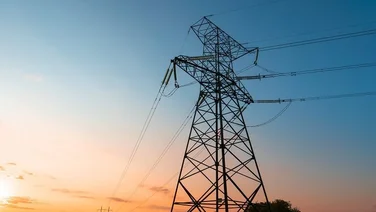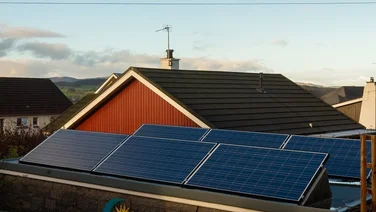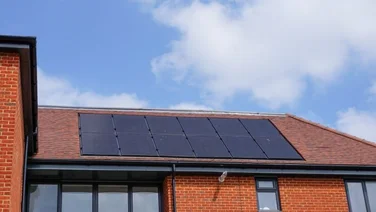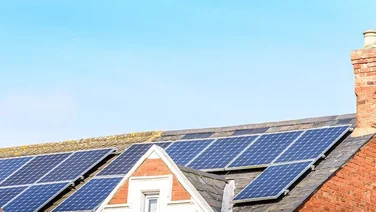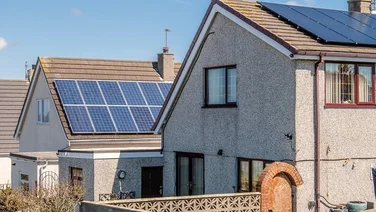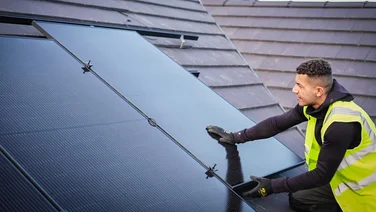- What is the Smart Export Guarantee?
- Smart Export Guarantee rates
- How do I apply for the Smart Export Guarantee?
- How much money can you earn from the Smart Export Guarantee?
- How is the Smart Export Guarantee different from the Feed-in Tariff?
- Will the government keep the Smart Export Guarantee?
- How many people have used the Smart Export Guarantee?
- Big energy suppliers must pay you for your excess renewable energy
- The best Smart Export Guarantee rate right now is around 27p per kWh
- The average home will make £160 per year from this scheme
The Smart Export Guarantee helps solar panel owners get paid for any solar power they generate but don’t use by allowing them to sell unused energy back to the grid.
With the Smart Export Guarantee, you can offset the installation costs of solar panels and other clean energy sources, shrinking your breakeven point by a few years, meaning you make your money back quicker.
On this page, we’ll tell you how the Smart Export Guarantee works, whether you’re eligible for it, and how much you could earn.
What is the Smart Export Guarantee?
- Launched in 2020 the Smart Export Guarantee is a government-backed initiative that compels large energy suppliers to pay homeowners for renewable energy they send back to the National Grid.
- You can get payments through the Smart Export Guarantee if you generate electricity with solar panels, small wind turbines, micro combined heat and power, hydropower, and anaerobic digestion.
- The Smart Export Guarantee replaced the Feed-in Tariff (FiT) in January 2020. It works differently as it puts responsibility on consumers to find the best rate for the electricity they generate.
- It particularly benefits homeowners with solar panels, because unless you have a solar battery, you’ll likely export half of your power back to the grid.
- The Smart Export Guarantee is part of the UK government’s strategy to reach net-zero emissions.
As an alternative to the Smart Export Guarantee, some people prefer to use a solar diverter to deal with excess energy.
This is a device used to direct excess electricity generated by the solar panels towards a specific appliance, such as water heaters, electric boilers, or electric vehicle charge points.
Some people also prefer to use a solar battery, which stores excess energy for later use.
Watch our short video below, which explains how the Smart Export Guarantee works:
How does the Smart Export Guarantee work?
- Households typically won’t use all of the energy their system produces, so the excess electricity gets exported back to the grid.
- The Smart Export Guarantee allows you to still benefit from that excess electricity, in the form of payments from an energy supplier participating in the scheme.
- Suppliers have their set rates for the electricity you export, but the highest you can get if you don’t own a solar battery is E.ON’s Next Export Exclusive tariff at 16.5p per kilowatt hour (kWh). This translates to roughly £219 a year.
- If you’re not willing to switch suppliers, the best rate is from Scottish Power at 12p per kWh. On this tariff, you’d earn around £159 a year.

Smart Export Guarantee rates
There are 13 companies licensed to offer Smart Export Guarantee rates, which can be any amount above zero.
This includes 11 that are compelled to, as they have at least 150,000 domestic electricity customers, and two – Pozitive Energy and Rebel Energy – that have voluntarily agreed to offer tariffs, though Rebel’s tariff is not publicly available.
Another supplier, Good Energy, offers an export tariff that isn’t connected to the Smart Export Guarantee but is the same in every other sense, so we’ve included it.
Here are the best and worst Smart Export Guarantee rates out there, as of June 2025.
| Energy supplier | Price (p/kWh) | Name of tariff |
|---|---|---|
Octopus (own customers with a GivEnergy solar battery) | 27* | Intelligent Octopus Flux |
Octopus (own customers with a solar battery) | 23.5* | Octopus Flux |
OVO (own solar customers with a battery) | 20 | OVO SEG Tariff |
Good Energy (own solar customers with a battery) | 25 | Solar Savings Exclusive |
E.On (own customers) | 16.5 | Next Export Exclusive |
Octopus (own customers) | 15 | Outgoing Fixed |
OVO (own solar customers) | 12 | OVO SEG Tariff |
Scottish Power (own customers) | 15 | SmartGen+ |
British Gas (own customers) | 15.1 | Export and Earn Plus |
Good Energy (own customers with a smart meter) | 15 | Solar Savings |
Scottish Power (non-customers) | 12 | SmartGen |
British Gas (non-customers) | 3.2 | Export & Earn Flex |
EDF (own customers) | 5.6 | Export Variable Value |
Utility Warehouse (customers) | 5.6 | UW Smart Export Guarantee – Bundle |
Pozitive Energy | 5 | SEG tariff |
So Energy | 4.5 | So Export Flex |
Octopus (non-customers) | 4.1 | Outgoing Go |
OVO (non-customers) | 4 | OVO SEG Tariff |
Utilita | 3 | Utilita Smart Export Guarantee |
EDF (non-customers) | 3 | Export Variable |
E.ON (non-customers) | 3 | Next Export |
Utility Warehouse | 2 | UW Smart Export Guarantee – Standard |
E | 1 | E SEG January2020v.1 |
We update our Smart Export Guarantee table regularly. Last updated on 20 June 2025.
* This tariff is variable. It varies depending on your location, and includes an off-peak period, so this is a representative rate.
Octopus offers the best Smart Export Guarantee rate, paying around 27p for every kWh of renewable electricity, on average.
This variable tariff, called Intelligent Octopus Flux, allows customers with a GivEnergy Solar battery to export electricity back to the grid at a peak rate between 4pm and 7pm. The peak rate will change depending on your postcode.
If you have a different type of solar battery, you can get 23.5p per kWh on the Octopus Flux tariff. The better rates are still only available to Octopus customers, though – households with other import suppliers will receive 4.1p per kWh.
The best Smart Export Guarantee rate that people without a battery can access is 16.5p per kWh, if you’re willing to switch to E.ON.
The best rate that anyone can access without switching is Scottish Power’s 12p per kWh tariff, called SmartGen. This tariff is available regardless of whether you’re a Scottish Power customer or not.
Octopus’s Christina Hess explained to The Eco Experts that the company can’t pay customers of other suppliers the same rate because “it takes a lot of effort to set up an export tariff – the process is therefore quite costly for us.
“However, if a customer also imports electricity from us, we’re more likely to make a margin (please note that due to the current grid set up of network admin, levies and distribution costs it’s usually net negative for us to offer any kind of export tariff).
“This means that we are able to offer a better rate to customers who export and import electricity through us.”
How do I apply for the Smart Export Guarantee?
Here’s what you must have:
- Your installation must have a maximum capacity of 5MW – which is far higher than any domestic property should need – unless it’s a micro combined heat and power installation, in which case the upper limit is 50 kW.
- You must provide your Microgeneration Certification Scheme (MCS) certificate, or an equivalent document.
- You must have an export meter – that is, a meter that’s capable of measuring your exported electricity.
- If you have a smart meter, you automatically qualify for the Smart Export Guarantee. If not, check that your meter is eligible with your supplier, as most will require you to have a smart meter before you receive payments.
- You’ll also need to give your Smart Export Guarantee company your export MPAN – a 13-number reference that your supplier can use to identify your electricity connection point. If you’re unsure about where you can find the export MPAN, just ask your supplier.
If you don’t have a MCS certificate, make sure that your installation and installer are certified. Ask your chosen Smart Export Guarantee company what information you need to provide.
This list of requirements may seem intimidating, but it’s simple, we promise. Just contact your chosen supplier, follow their requirements, fill in their application form, and you’ll be accepting Smart Export Guarantee payments in no time.
Solar panels
By far the most popular form of residential electricity generation, solar panels are suitable for a wide variety of property types, and are relatively easy to install and finance.
To discover what loans for solar panels are available, and other finance help, visit our dedicated.
Solar panels work by converting sunlight into electricity, although the sun doesn’t need to be shining for this to happen. Solar panels work just fine on cloudy days, so you’ll save on energy bills with them even if you don’t live in a sunny area.
Installing green technology such as solar panels alongside finance schemes such as the Smart Export Guarantee would help lower the average electricity bill in the UK.
Domestic wind turbines
Domestic wind turbines generate electricity using the power of the wind. They’re like those big turbines you see in wind farms, only smaller.
Wind turbines aren’t as popular as residential solar panels because they generally require a wide open space, far away from any trees or buildings, in order to reach their full potential.
Micro combined heat and power
A micro combined heat and power (micro-CHP) system uses the same energy source to generate both heat and electricity.
They’re primarily used for heating, and most systems have a six to one ratio of heat to electricity production, according to the Energy Saving Trust.
Micro-CHP systems usually use gas as a power source, so the electricity they generate isn’t emission-free. The most common type of micro-CHP is an internal combustion engine, typically an engine connected to an electric generator.
Hydropower
A hydropower system generates electricity using water. This type of system isn’t very popular in residential settings, since it requires you to have a source of flowing water on your property.
However, if you’re lucky enough to have a river or stream in your back garden, and it’s got strong flow, a micro hydropower system could produce more than enough electricity to power your home.
Anaerobic digestion
Anaerobic digestion is a niche way to generate electricity. It involves using bacteria to break down organic matter (food waste, manure, wastewater) in a closed chamber, which creates biogas.
Biogas is mainly methane, and can be used to produce heat or generate electricity, in a similar way natural gas is used. This means it’s not an emission-free form of electricity generation, but it is renewable.
You need much more than a simple compost bin to generate electricity through anaerobic digestion, but it might be a good option for you if you have a large farm.
Do you need a smart meter in order to receive Smart Export Guarantee payments?
Some suppliers do require you to have a smart meter in order to receive Smart Export Guarantee payments.
Having one will also ensure you’re paid accurately for the energy you export, and will mean you don’t have to take manual readings – plus it may soon become compulsory, so we would advise having one.
Ready to invest in solar?
Generate free, green electricity Reduce your electricity bill by up to 64% Get paid for what you don't use
Can you choose any supplier for the Smart Export Guarantee?
Technically you can choose any supplier for your Smart Export Guarantee tariff, but some reserve their highest rates for existing customers.
Octopus, Scottish Power, EDF, and E.ON, for example, all offer higher tariffs to households that receive electricity from them. Meanwhile, OVO, Good Energy, and So Energy offer preferential Smart Export Guarantee rates to homeowners who have used them for solar panel installation.
Depending on what stage you have reached on your solar panel journey, it’s worth looking at the Smart Export Guarantee rates your existing energy supplier will offer, and shopping around to make sure you get the maximum benefit.
Where do you want to install solar panels?
Get startedHow much money can you earn from the Smart Export Guarantee?
Based on the hours of daylight we have in the UK, the owner of a three-bedroom house with a 3.5 kWp solar panel system will earn £159 per year on average from the Smart Export Guarantee with Scottish Power’s 12p per kWh rate, which anyone can sign up for.
However, your household isn’t average – so we’ve created tables that show how you can expect the size and location of your home to affect your Smart Export Guarantee earnings.
Smart Export Guarantee income based on property location
Location is another crucial aspect in determining how much you’ll receive in annual Smart Export Guarantee payments.
There can be as much as a 36% difference in how much you’re paid, purely because of how much sunshine you get where you live, but it’s still worth it. Even if you’re getting solar panels in Scotland, which tends to get less sunshine than the rest of the UK, you’ll still save on your electricity bills.
Here’s how much the owner of a 3.5kWp system (which you’d typically put on a three-bedroom house) can expect to be paid annually in different parts of the UK.
If you want to take advantage of Smart Export Guarantee payments, fill in this form with a few details, and one of our trusted suppliers will be in touch to give you a competitive quote for solar panels on your home.
| Region | SEG payment | Years to break even |
|---|---|---|
South Wales | £181 | 12.4 |
South East England | £179 | 13 |
Midlands | £156 | 14.8 |
North West England | £157 | 14.3 |
North Scotland | £133 | 17.7 |
Smart Export Guarantee income based on size of solar panel system
As long as you buy the right size solar panel system for your home and pay a fair price (around £703 per panel), you should break even in little over a decade, regardless of your home’s size.
However, the number of solar panels you have is vital in working out how much you’ll make from the Smart Export Guarantee each year.
| House size | No of panels | System kWp | Annual SEG earnings (£) |
|---|---|---|---|
1-2 bedrooms | 6 | 2.1 | £95 |
3 bedrooms | 10 | 3.5 | £159 |
4+ bedrooms | 14 | 4.9 | £222 |
How is Smart Export Guarantee income paid to you?
If your Smart Export Guarantee company also supplies your electricity, your payment may come in the form of a deduction from your monthly energy bill. If not, you’ll be paid by bank transfer.
Suppliers are allowed to choose how frequently they send these transfers – and they vary enormously.
For example, Scottish Power will pay you monthly, OVO’s payments are quarterly (as are E.ON’s, as long as you request them each time), and Shell will pay you annually – though it’ll only send you payments in May.
Make sure you check how often your Smart Export Guarantee supplier intends to pay you before you sign up.
Is Smart Export Guarantee income taxable?
Your Smart Export Guarantee income will be exempt from tax, as long as:
- Your solar array is located on a domestic property you own, or nearby
- You don’t intend for your panels to produce significantly more solar power (usually interpreted as 20% more) than the amount of electricity you consume at home
If your installation doesn’t match these requirements, you may still be exempt. You can class your Smart Export Guarantee payments as trading and miscellaneous income, and provided your total income in this category doesn’t exceed £1,000, you won’t have to report it to HMRC.
How is the Smart Export Guarantee different from the Feed-in Tariff?
The Smart Export Guarantee replaced the Feed-in Tariff (FiT), which has ended.
The Smart Export Guarantee is an export tariff where suppliers pay you for the renewable energy you send to the Grid.
The Feed-in Tariff (FiT) offered this as well, but it also compelled suppliers to pay a generation tariff.
That meant FiT recipients were paid for all the renewable power they produced, as well as receiving export payments for the green energy they sent to the Grid.
In the FiT era, the export tariff was paid on the assumption that households would export 50% of the renewable energy they generated, and it was paid on a standard rate.
With the Smart Export Guarantee, you’ll receive a different rate depending on which supplier you choose, and you’ll be paid based on the amount of electricity you actually export, rather than an assumed 50%.
The other main difference between the two is that the FiT was funded by a tax on all consumers’ energy bills, while the Smart Export Guarantee is paid for by suppliers.
What happens if you’re already earning FiT payments?
You can continue receiving generation tariff income regardless of whether you’re on an Smart Export Guarantee tariff or not, but you can’t get both FiT and Smart Export Guarantee export payments.
Though the FiT ended in March 2019, customers who signed up before that date can still receive payments for the duration of their contract, which is usually 20 years.
Once every 12 months, you can switch from your FiT export tariff to the Smart Export Guarantee – but we only recommend taking this step if you’re sure it will lead to higher payments.
Is the Smart Export Guarantee good enough?
The Smart Export Guarantee is a positive development, but it goes nowhere near far enough towards rewarding solar households or encouraging prospective buyers.
The best Smart Export Guarantee tariff is Octopus’s 27p per kWh average offering, exceeding the standard rate consumers pay for electricity, which is currently 22.36p per kWh. But it’s only available to its customers who also have a GivEnergy solar battery.
If you don’t have a solar battery, the best rate is 16.5p from E.ON, or if you don’t want to switch suppliers, the highest open-to-all tariff is 12p per kWh from Scottish Power.
That means the Smart Export Guarantee allows companies to buy electricity from you for on average less than half the price they charge you. At worst (yes E, we’re looking at you), you’re being underpaid by 96%.
Scottish Power’s 12p rate is at least much higher than the Feed-in Tariff’s last export rate, which was 3.8p per kWh when it ended in 2019.
That shouldn’t be the benchmark, though. Energy prices have risen too far, too quickly for that number to be relevant.
The government has rightly stepped in to ensure your unused solar power isn’t sent to the grid for free, but solar panel owners are still being massively underpaid for the electricity they generate.
The surprising thing about the Smart Export Guarantee is how few homeowners know about it, the National Home Energy Survey 2024, found that just 3% of homeowners were even aware of it.
National Home Energy Survey 2024
Read the full findings from this year's NHES report by downloading the PDF here.
Will the government keep the Smart Export Guarantee?
Yes, in fact it has done and is increasing the amount it gives to schemes through the Warm Homes Plan.
In its manifesto before the election, Labour promised to offer grants and low interest loans to help households cut bills through insulation, solar panels, and low carbon heating, to the tune of £6.6 billion by 2030.
As well as homeowners, it has pledged to help out renters too by ensuring homes in the private rented sector meet minimum energy efficiency standards by 2030, which it said will save renters “hundreds of pounds per year”.
This is a very strong indication that initiatives such as the Smart Export Guarantee will remain in place.
Will the Smart Export Guarantee increase?
Eight of the 13 Smart Export Guarantee suppliers have raised their rates since the start of 2023.
As a result of increasing their tariffs or introducing new, higher ones, Octopus, and Scottish Power now offer the best rates on the market.
However, many companies have long refused to raise their rates, and customers continue to be underpaid for the electricity they generate as a result.
Overall, energy companies pay households just 35% of what their solar energy is worth.
You should still sign up for an Smart Export Guarantee tariff, because otherwise you’re leaving money on the table – but solar power is worth more than this.
And, if the UK is to reach net-zero emissions by 2050, the government needs to do more to make solar power more appealing. Raising Smart Export Guarantee rates across the board is one way to do it.
How many people have used the Smart Export Guarantee?
Plenty, and it is getting more popular every single year. According to Ofgem, a total of 283,666 installations were registered to a Smart Export Guarantee tariff during 2023-2024. This is a massive threefold increase from the 92,946 installations reported between 2022 and 2023.
The 283,666 installations had a combined total capacity of 1,563.2MW, which is the equivalent of 3.5% of peak UK electricity demand.
In the same period, £30.7 million was paid out to Smart Export Guarantee generators, an incredible 327% on the £7.2 million paid between 2022-2023.
On top of that, between 2023-2024 238 GwH of electricity was exported back to the grid, which was enough to power 88,198 UK homes for a year.
What do solar panel owners think of the Smart Export Guarantee?
We spoke to Elan, who lives in the South West of England, about his solar panels and how he used them to take advantage of the Smart Export Guarantee to save close to £1,000 a year.
“I’m based in the South West and had a 4.5kW solar panel system installed a couple years ago,” Elan explained.
“For the Smart Export Guarantee tariff, I was already an OVO customer so I was able to get on its Smart Export Guarantee Beyond Exclusive tariff. Unfortunately I don’t have a solar battery, so I currently can’t move to the Smart Export Guarantee Install Tariff.”
“Still, at 12p per kWh, the rates aren’t that bad! It’s not the best on the market I know, but I’ve been with OVO for a while and haven’t had any issues with them in the past, so it made sense to me at the time to stick with them for the Smart Export Guarantee. I save around £950 a year on my bills from Smart Export Guarantee payments, so I am quite happy with that.”
“Would I recommend getting solar panels purely for the Smart Export Guarantee? No, but that’s because I got panels to do my bit for the planet! Any money I make from the Smart Export Guarantee is just a little bonus really.
“What is nice is that I’ll be able to pay back what I spent on the solar panels a fair bit faster than if I weren’t using the Smart Export Guarantee. So if you’re committed to going solar, there’s basically zero reason not to use the Smart Export Guarantee.”
Summary
- You can qualify for the Smart Export Guarantee if you generate electricity with solar panels, small wind turbines, micro combined heat and power, hydro or anaerobic digestion.
- The average solar panel owner can make around £159 a year from exporting excess electricity back to the grid.
- If you have a smart meter, you automatically qualify for the Smart Export Guarantee.
- The UKgovernment is keeping the Smart Export Guarantee and other initiatives.
- Just fill in this form with a few details, and our expert suppliers will be in touch with a quote for solar panels on your home.


